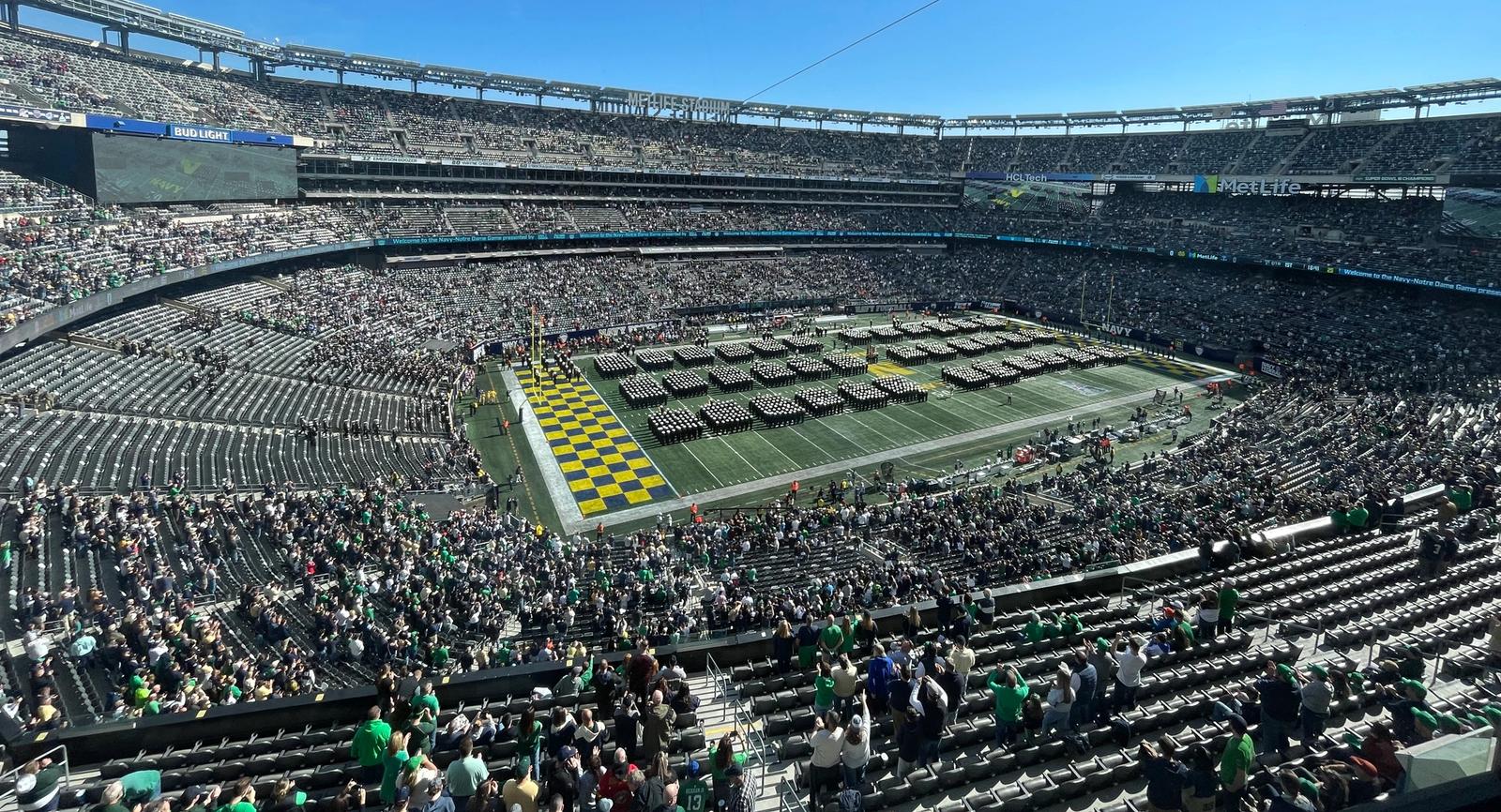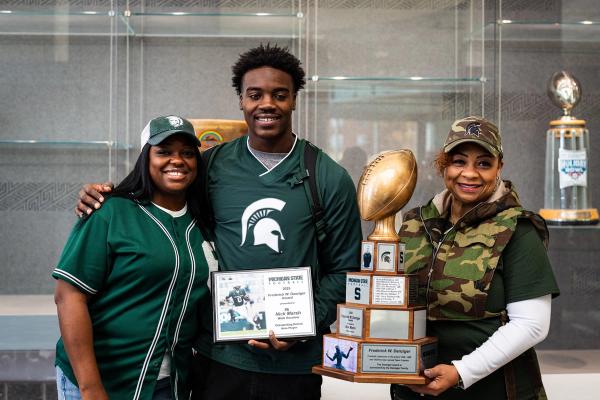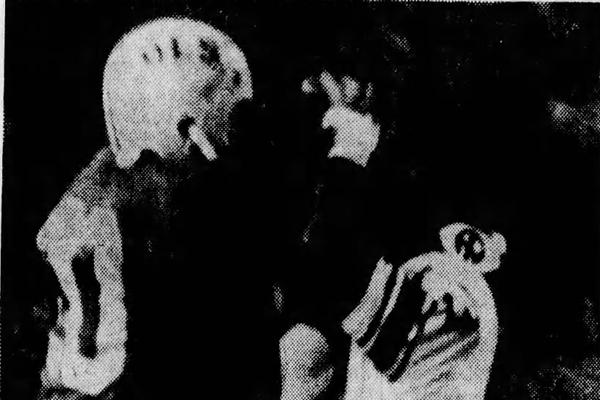•
Written By
Written By
•
•
•
Loading article...
Written By
Written By
Notre Dame-Navy remains a stalwart in the ever-changing college football landscape. I tried to find the words to express what this series means to the sport.
Written By
Omar-Rashon Borja
Senior Writer, Editor, Historian
Written By
Omar-Rashon Borja
Senior Writer, Editor, Historian

Before the Shamrock Series, Notre Dame had Notre Dame-Navy. After Notre Dame’s monumental clashes against Army at Yankee Stadium ceased and they stopped playing as frequently at Chicago’s Soldier Field, the Fighting Irish’s traveling show slowed considerably. Or at least it seemed that way.
During the days of Dan Devine, Gerry Faust, and Lou Holtz, the Navy game was the biannual coming out party of Notre Dame’s famed “Subway Alumni”. Traveling from the Great Lakes of Cleveland to the City of Brotherly Love to the Charmed City and even the Sunshine State, Notre Dame-Navy was a modern-day take of Notre Dame going to big professional sports hubs to advance their brand.
When Army and Notre Dame left the Big Apple, Navy-Notre Dame took its place. Giants Stadium may not have been Yankee Stadium or Ebbets Field, but it did its job as the New York City metro’s home of Notre Dame’s showdowns with Military Academies. Johnny Lujack and Angelo Bertelli may not have taken the field at The Meadowlands, but Jerome Bettis and Brady Quinn did Saturday marked the eighth time Notre Dame and Navy played in East Rutherford.
Despite this tradition, some question the necessity of this game. With mega conferences making independent life more difficult than ever and the hyper-focus on the College Football Playoff, some wonder why the two schools play the game. After all, Notre Dame holds an 83-13-1 edge in the series. Anyone who watched in person or on TV had all doubts about the viability of this game answered.
“The Promise.” Everyone who knows anything about this rivalry knows about the time-tested promise. Notre Dame promised a spot on their schedule for eternity to Navy. Many do not realize college football’s deep connection to the World Wars. During World War I, the Great War, Military teams saved the Rose Bowl. In 1919, with most college-aged men “Over There” in Europe, Mare Island and Great Lakes Navy ensured the “Granddaddy of Them All” took place. Three years removed from the Rose Bowl’s return from a 14-year hiatus, these two Military teams could have saved the Rose Bowl. There is an argument to be made.
A little over two decades later, Nile Kinnick won the Heisman and turned down a lucrative deal to play in the NFL to go to law school. Kinnick would leave law school due to convictions to prepare to assist in the growing world conflict developing in Europe and Asia.
His Heisman speech still rings immortal.
Becoming a Naval pilot, Kinnick passed away when his plane crashed during a training flight. Over 80 years after his death, his story remains a well-known testimony of the mystique of the Heisman and its angelic standing in sports. College football’s complicated connection to military service amplifies this.
College football and the World Wars are simply intertwined. Notre Dame-Navy is one of the last symbols of both World Wars’ impacts on the game. The story of the U.S. Navy opening a Naval training site to keep Notre Dame open during the war. The strange teams named after airfields or flight training schools may be long gone, but Notre Dame’s promise to Navy to play yearly for eternity lives on. A favor done in goodwill represents the necessity required during those times.
The series was competitive at first, but as the popularity of pro football widened the gap between the two. After the last Heisman Trophy winner departed Annapolis, Notre Dame embarked on the infamous 43-year winning streak. Navy has since broken the streak, but there were few times when the game had national implications for both teams. 2024 was a much-appreciated return to the days of Roger Staubach, Joe Bellino, Leon Hart, and Johnny Laettner where the national title ran through the Notre Dame-Navy game.
Of course, this year, Navy and Notre Dame appeared in the top 25, which caught everyone’s attention, but perhaps the most important aspect of this game was its television situation. ABC aired this year’s Notre Dame-Navy game, a rare distinction for a game outside the SEC.
While the SEC and Big Ten continue to usurp the college football landscape, the TV executives showed Notre Dame-Navy holds weight. Sadly, had both teams not been ranked, this game would have probably ended up on ESPN. After all, ESPN aired Notre Dame’s October 19th game against Georgia Tech on its cable network instead of ABC. Who knows if ABC will carry the next Navy home end in the Notre Dame series?
Much is made about the history of Notre Dame-Navy, but hardly anyone writes about the actual gameday experience. Notre Dame-Navy is truly another Shamrock Series for the Irish. Two years ago, I met plenty of Subway Alumni in Baltimore. I briefly talked with one gentleman while touring Babe Ruth’s childhood home who moved to Baltimore from Seattle and was finally able to watch the Irish play again. He did not graduate from Notre Dame. Stories like these are plentiful and on full display at Notre Dame-Navy.
There is hardly any NFL venue better for the game than MetLife Stadium. The Notre Dame-Navy rivalry is one of college football’s most-traveled rivalries, making appearances on the Atlantic coast and Pacific coasts, to Rust Belt outposts, and even across the Atlantic to Ireland. Yet, Notre Dame and Navy’s deep connections to the Meadowlands last.
When getting breakfast in the press box, I conversed with the lady serving my food. She complimented my vintage New York Giants sweater. I told her I wanted to honor the Bill Parcells era. I also mentioned how awesome it was to see Navy play at MetLife since Navy great Phil McConkey won a Super Bowl with the team. She paused and her face lit up as she said, “I’ve worked here for a while. I love Phil.” We then reminisced about his touchdown in the Super Bowl and the other greats from the Giants run in the 1980s like Mark Bavaro.
Beyond the pro connections of Phil McConkey and Mark Bavaro, the Meadowlands has been the backdrop for the rivalry on seven other occasions and the site for many iconic moments for both programs. In 1984, Giants Stadium saw John Carney crush Navy’s hopes of ending the streak with a game-winning field goal in the final minute. In 2010, Alexander Teich’s 210 yards helped Navy demolish Notre Dame 35-17 in a rare series win for the Midshipmen. Beyond these moments, the Midshipmen and Irish have several other iconic moments at the Meadowlands. The list goes on between Notre Dame’s Kickoff Classic appearances and cherished Navy memories against Army like Frank Schenck’s game-winning field goal with 10 seconds left in 1989 or Craig Candeto’s seven-touchdown game in 2002.
In addition to history, Notre Dame-Navy offers a taste of this military precision and professionalism with the Brigade of Midshipmen marching onto the field before the game. The sports world reveres the pageantry of Army-Navy, but it is becoming increasingly difficult for fans to experience one of college football’s “bucket list” games. Tickets for this year’s Army-Navy game are over $800, but Notre Dame-Navy tickets were $80 before kickoff. The most famed tradition of Army-Navy is the March-On, where both Academies have their student bodies march on and off the field.
While West Point’s Corps of Cadets may not be present, having one of the two Academies is a worthy consolation. In the press box, journalists’ slowly arose as the companies descended on the playing surface. People still revere the principles of discipline and professionalism consistently displayed by the Academies.
Notre Dame-Navy is Military football’s yearly “cup of coffee in the big time.” The stage was monumental, and Navy Head Coach Brian Newberry said as much in his postgame presser. Like Notre Dame, the rivalry is a reminder of past times when Navy sold out pro stadiums themselves. Although the crowd was very pro-Irish, this year harkened back to those times.
Navy was its own worst enemy on Saturday, turning the ball over six times and fumbling on seven occasions. The Midshipmen fell behind early and showed brief glimmers of hope, but Notre Dame ultimately pulled away, 51-14. Navy’s current losing streak to the Irish may not be close to their 43-year drought, but it is growing with this being the seventh straight loss in the series.
Still, with each loss the hope Navy can upset might Notre Dame grows. This hope provides a mystique that adds to the rivalry. The sports world waited each year for the Cubs to win a World Series. In the same way, each year, college football fans whether Navy has a good enough team or if Notre Dame is in a big enough slump for the Midshipmen to come out on top. This “will they, won’t they?” suspense keeps fans tuned in, and the payoff of a Navy win warms the soul.
So what is there to say after this rambling? You do not need me to harp on the loss of old rivalries over petty hosting agreements or the shuffling of conferences. College football has lost enough rivalries that each rivalry lost is merely a formality. Notre Dame-Navy embodies the value of keeping one’s word. Eternity means eternity, and both schools mean it. Navy may have only one free non-conference slot each year but it does not matter. The Notre Dame game prevails.
Notre Dame-Navy provides a peek into a past era of college football. Notre Dame may be independent, but its fans still flock to the Big Apple as they have since the 1920s. A pro stadium sells out to watch Service Academy football. Conferences may shuffle and traditions disappear, but Notre Dame-Navy lasts.

